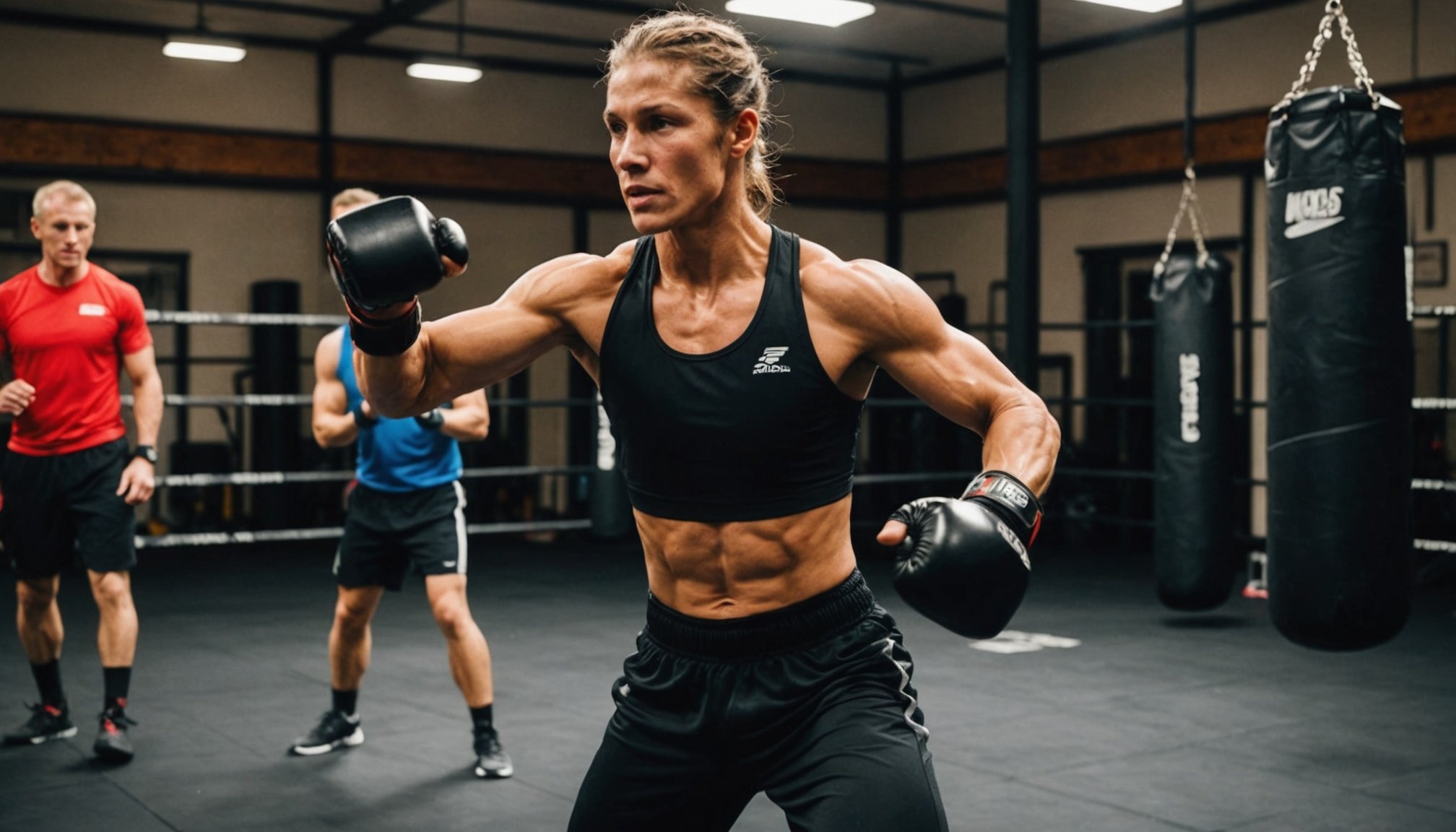Exploring the Hottest Aerobic Conditioning Trends for Kickboxers in the UK
In the dynamic world of kickboxing, staying ahead of the curve in terms of fitness and conditioning is crucial for success. The UK, with its vibrant martial arts scene, is no exception. Here, we delve into the latest aerobic conditioning trends that are making waves among kickboxers, and explore how these methods can enhance performance, reduce injuries, and promote overall health.
The Importance of Aerobic Conditioning in Kickboxing
Aerobic conditioning is the backbone of any successful kickboxing training program. It enhances cardiovascular endurance, allowing fighters to sustain high-intensity efforts over multiple rounds. Here’s why aerobic conditioning is so vital:
Also read : Essential Safety Guidelines for Sparring in UK Taekwondo Clubs: Protecting Practitioners First!
Cardiovascular Endurance
Aerobic exercises improve the heart’s efficiency in pumping blood, which is essential for delivering oxygen and nutrients to the muscles during prolonged physical activity. For kickboxers, this means being able to maintain a high level of intensity throughout the fight without succumbing to fatigue.
Weight Management
Effective aerobic conditioning also aids in weight management, a critical aspect for fighters who need to meet specific weight categories. High-intensity interval training (HIIT), for example, is a popular method that not only improves cardiovascular fitness but also helps in weight loss.
Have you seen this : Top Breathing Techniques for UK Karate Competitors: Boosting Performance and Focus
Injury Prevention
A well-structured aerobic conditioning program can help prevent injuries by improving muscle endurance and reducing the risk of overuse injuries. This is particularly important in combat sports like kickboxing, where the risk of injury is inherently high.
Current Trends in Aerobic Conditioning for Kickboxers
High-Intensity Interval Training (HIIT)
HIIT has become a staple in many kickboxing training programs. This involves short bursts of high-intensity exercise followed by brief periods of rest. Here’s a detailed example of a HIIT workout:
- Warm-up: 5-10 minutes of light cardio (jogging, jumping jacks)
- Sprints: 30 seconds of sprinting followed by 30 seconds of rest
- Burpees: 30 seconds of burpees followed by 30 seconds of rest
- Kettlebell Swings: 30 seconds of kettlebell swings followed by 30 seconds of rest
- Cool-down: 5-10 minutes of stretching
HIIT is praised for its efficiency and effectiveness in improving both cardiovascular fitness and muscular endurance.
Group Fitness Classes
Group fitness classes, such as kickboxing fitness or boot camp-style workouts, are gaining popularity. These classes offer a social and motivating environment that can enhance adherence to training programs.
Benefits of Group Fitness Classes:
- Social Support: Training with others can boost motivation and accountability.
- Variety: Classes often include a mix of exercises, reducing the monotony of solo workouts.
- Expert Guidance: Instructors provide proper form and technique, reducing the risk of injuries.
- Time-Efficient: Classes are typically structured and timed, making it easier to fit into a busy schedule.
Strength Training
While strength training is often associated with anaerobic exercises, it also plays a crucial role in aerobic conditioning. Building muscular strength enhances the body’s ability to perform high-intensity aerobic exercises.
Key Strength Training Exercises for Kickboxers:
- Squats: Enhances leg strength and stability.
- Deadlifts: Improves overall lower body strength and core stability.
- Bench Press: Strengthens the upper body, particularly the shoulders and chest.
- Planks: Enhances core strength and stability.
Mental Health and Aerobic Conditioning
Mental health is an often-overlooked aspect of athletic training, but it is equally important as physical fitness. Aerobic conditioning has been shown to have positive effects on mental health.
Reducing Stress
Regular aerobic exercise releases endorphins, which are natural mood elevators. This can help reduce stress and anxiety, common issues among athletes.
Improving Focus
Aerobic exercise has been linked to improved cognitive function, including better focus and concentration. For kickboxers, this can translate to better performance in the ring.
Practical Insights and Actionable Advice
Creating a Balanced Training Program
A balanced training program should include a mix of aerobic conditioning, strength training, and technical skill practice. Here’s an example of how to structure a weekly training plan:
| Day | Training Focus | Example Workout |
|---|---|---|
| Monday | Aerobic Conditioning | 30 minutes of HIIT (sprints, burpees, etc.) |
| Tuesday | Strength Training | Squats, deadlifts, bench press, planks |
| Wednesday | Rest Day | |
| Thursday | Technical Skill Practice | Sparring, bag work, pad work |
| Friday | Aerobic Conditioning | 30 minutes of steady-state cardio (jogging, cycling) |
| Saturday | Group Fitness Class | Kickboxing fitness class or boot camp |
| Sunday | Rest Day or Active Recovery | Light yoga or a leisurely walk |
Monitoring Progress and Avoiding Burnout
It’s crucial to monitor progress and avoid burnout. Here are some tips:
- Keep a Training Log: Track your workouts to see how you’re progressing.
- Listen to Your Body: Rest when needed; overtraining can lead to injuries and burnout.
- Mix It Up: Vary your workouts to avoid monotony and prevent plateaus.
In the fast-paced world of kickboxing, staying on top of the latest aerobic conditioning trends can make all the difference. By incorporating high-intensity interval training, group fitness classes, and strength training into your regimen, you can enhance your performance, reduce the risk of injuries, and promote overall health and well-being.
As kickboxer and fitness enthusiast, Sarah Johnson, notes: “Aerobic conditioning is not just about physical fitness; it’s also about mental toughness. When you’re in top shape, you feel more confident and prepared for any fight.”
By embracing these trends and integrating them into your training program, you can take your kickboxing skills to the next level and achieve your goals in this demanding yet rewarding sport.











